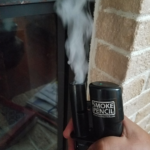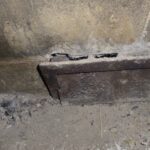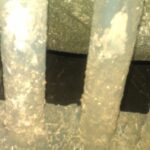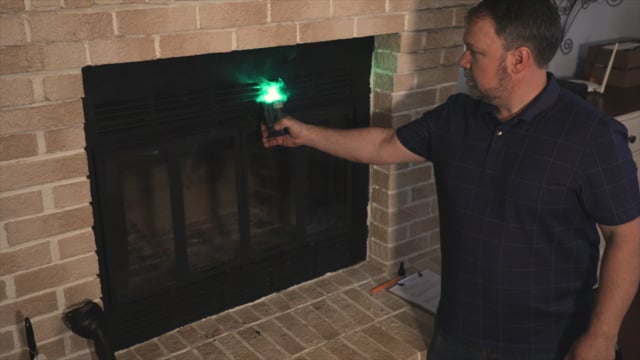How to use a Smoke Pencil in a fireplace to test for smoke draft, air leakage, or downdraft.
Fireplaces are designed to move air. The Dept of Energy estimates the fireplace makes up 14% of a homes air leakage. But many times we do not want our fireplace to do move air. We just want our fireplace to sit there in the corner and look pretty, and not let in outside air that is too hot or too cold, or suck out our inside air that we paid dearly for our HVAC to condition. But despite your best efforts of air sealing and troubleshooting, you still get drafts or smells coming from the fireplace.
Using a Smoke Pencil in a fireplace is the right tool to visualize the air currents

Smoke Pencil in a Fireplace
Air infiltration can come from an number of locations in a fireplace, Here are a few: the chimney, the brick connections, the fresh air intake, the ash chute, outside ash dump door, the glass door, the heat exchanger, etc…So even if you have a Chimney Balloon or a Flueblocker installed in your fireplace, you may still have air movement in your firebox that needs to be addressed.
Below is a video of how the Smoke Pencil in a fireplace can be used to visualize the swirling air currents.
It can be tricky to know whether the air is coming from up the flue or from the walls or the floor of the firebox. So the Smoke Pencil in a fireplace allows you to make puffs of vapor or trailing lines of vapor so you can pinpoint where the air is coming from.
Here is a list of some of the areas to check in your fireplace for air infiltration:

Ash chute door
- Ash Chute Dump: On the floor of your fireplace there can be a small trap door or a grate that leads to a hollowed out chute below. This is an ash chute. It is a cleanout for the firebox so you don’t have to scoop out the ashes after a fire. But it is always best to scoop out the ashes from the firebox, so you can get them out of the house. Ashes left in the chute can retain a burnt smell and that will come up from the chute and stink up the house.
- Ash Chute Dump Cleanout Door: If you have an ash chute, there there will be a cleanout door or port either on the outside wall of your fireplace, or in your basement or crawlspace. These doors are notoriously leaky and provide a perfect location for air to get sucked into the firebox.
- Fresh air intake: There is sometimes a fresh air intake on the side of the firebox wall. It directly lets in outside air for the fire. But it is also very drafty when not in use. Sometimes in factory built or prefabricated zero clearance fireplaces, you wont even see them because they are hidden behind the fire brick layer. But if air is getting sucked through the wall of the firebox, you will know that you have a fresh air intake.

fireplace heat exchanger
- Heat exchanger: Many hearth constructions have grates that look like they serve no purpose, but they are part of a rudimentary heat exchanger. The thought is, if they leave open pockets around the firebox then those pockets will collect warm air during a fire. That air will circulate and come out into the room. Some even have fans attached to force the air around. But those air pockets can also let in outside air.
- Glass Doors: It may seem counterintuitive but glass doors can let in outside air in prefabricated fireplace. The glass door tracks are built into the metal box that also has the damper and chimney and attach the firebox walls. Those metal attachments can leak air, and it shows up through air infiltration the glass door tracks.
